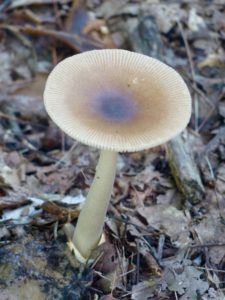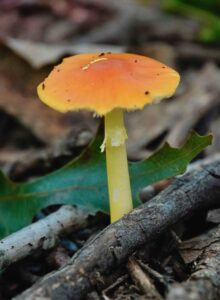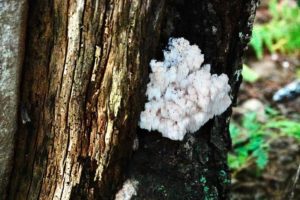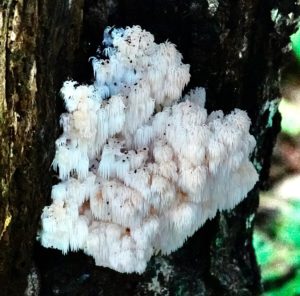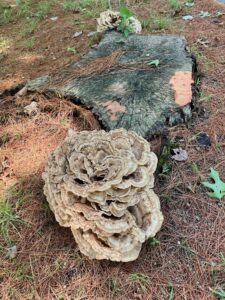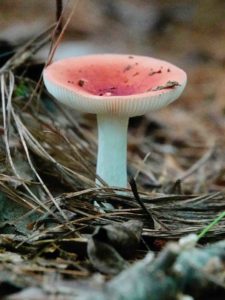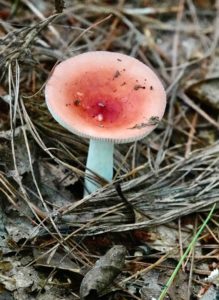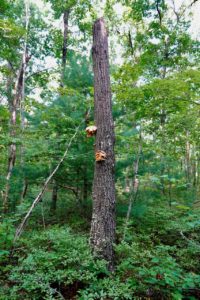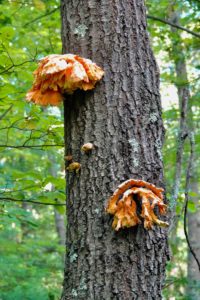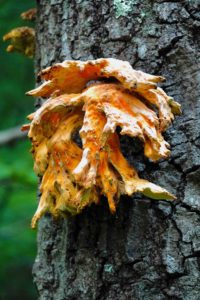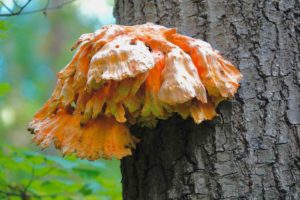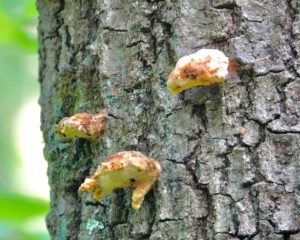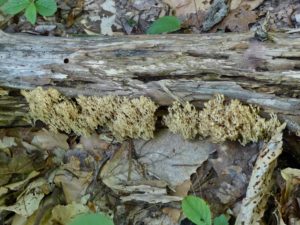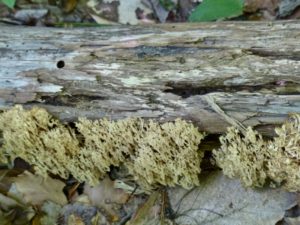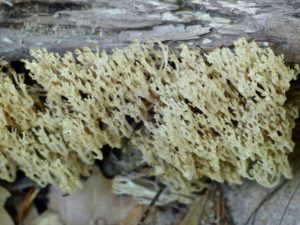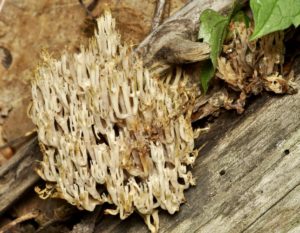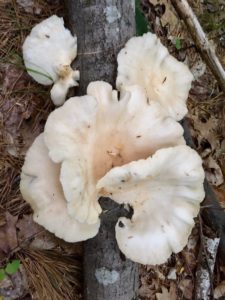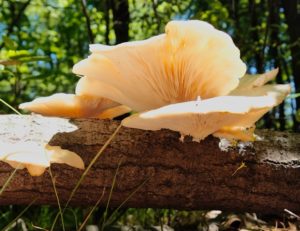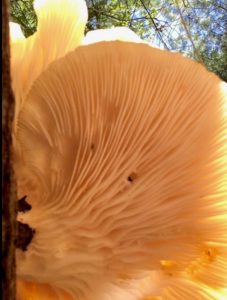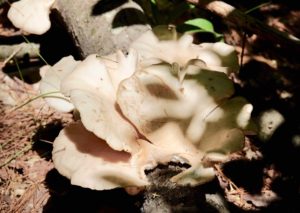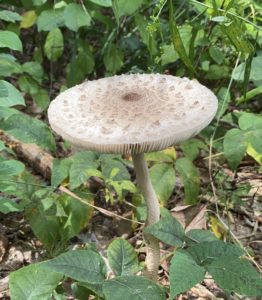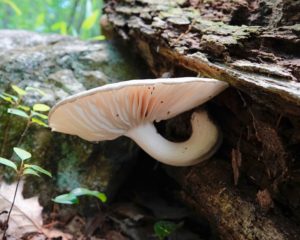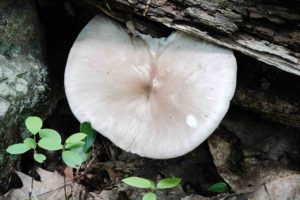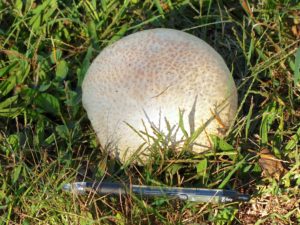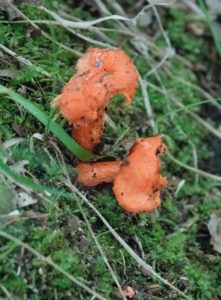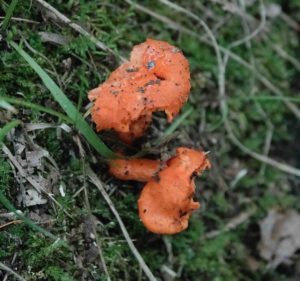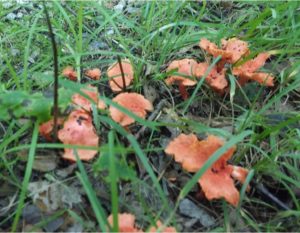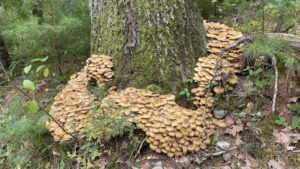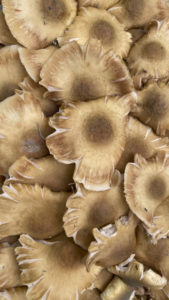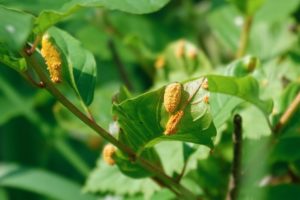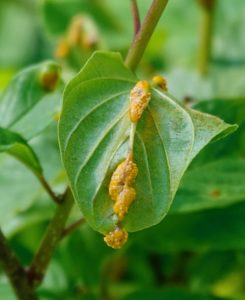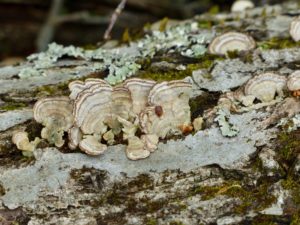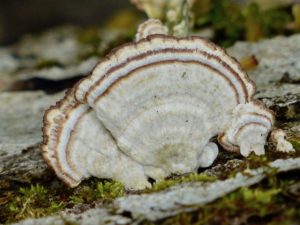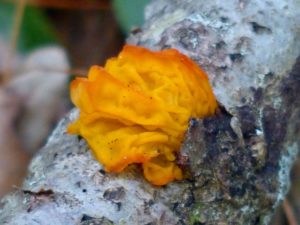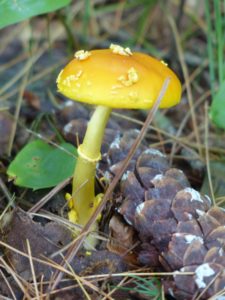Sightings – Mushrooms and Fungi
Observer: Paul Lauenstein
Observation Date: 8/15/18
Observation Time: 12:15 p.m.
Observation Location: Moose Hill Audubon Wildlife Sanctuary
Common Name: Amanita mushroom
Scientific Name: Amanita sp.
Comments: The genus of this mushroom is probably Amanita, but it’s hard to say which of the numerous species of Amanita this is. Mushrooms of the genus Amanita account for most mushroom-related deaths.
More information: MushroomExpert.com
Observer: Paul Lauenstein
Observation Date: 9/4/20
Observation Time: 1:30 p.m.
Observation Location: Moose Hill Farm
Common Name: Amanita mushroom
Scientific Name: Amanita sp.
Comments: The genus of this mushroom is probably Amanita, but it’s hard to say which of the numerous species of Amanita this is. Mushrooms of the genus Amanita account for most mushroom-related deaths.
More information: MushroomExpert.com
Observer: Paul Lauenstein
Observation Date: 10/6/21
Observation Time: 3:00 p.m.
Observation Location: Near the footbridge over Beaver Brook near the outbound train station
Common Name: Bear’s Head Tooth Fungus (a.k.a. Lion’s Mane or Comb Tooth)
Scientific Name: Hericium americanum
Comments: While driving very slowly along the dirt road from the outbound train station parking lot to the footbridge over Beaver Brook, I almost drove past this bizarre fungus growing on a dying tree trunk. This year was exceptionally wet, which has led to more mushrooms than usual this fall.
Bear’s Head Tooth Fungus is native to eastern North America. It was first scientifically described by James Ginns of Canada in 1984. Bear’s Head Tooth Fungus grows on both rotting and living wood, mostly hardwood, and they are typically seen in the wild during the late summer and autumn months, though they are able to be cultivated.
Young Bear’s Head Tooth Fungus can be cooked and eaten, having a taste comparable to that of lobster, though once picked the fungi do not store well, and need to be consumed within a couple of days. Otherwise they will become bitter. High amounts of vitamin D are found in Bear’s Head Tooth Fungus, and it also contains significant quantities of protein and fibre, as well as other beneficial health properties that are still being understood. However, I never eat mushrooms or fungi that I find in the wild. With plenty of mushrooms available in the supermarket, I don’t think it’s worth the risk.
More Information: Wikipedia and ediblewildfood.com
Observer: Paul Lauenstein
Observation Date: 8/10/24
Observation Time: 3:20 p.m.
Observation Location: beside Wolomolopoag St.
Common Name: Black-staining Polypore
Scientific Name: Meripilus sumstinei
Comments: These two large fungi were growing by a large stump. One of them was beginning to turn black.
More Information: Maryland Biodiversity
Observer: Kurt Buermann
Observation Date: 7/14/13
Observation Time: 11:00 a.m.
Observation Location: backyard
Common Name: Bondarzewia
Scientific Name: Bondarzewia berkeleyi
Comments: This was growing on an old oak stump. Very large, 2 ft long clusters. It grew very quickly, over a day or so. This is not chicken-of-the-woods, but is edible if gathered when very young.
More Information: MushroomExpert.com
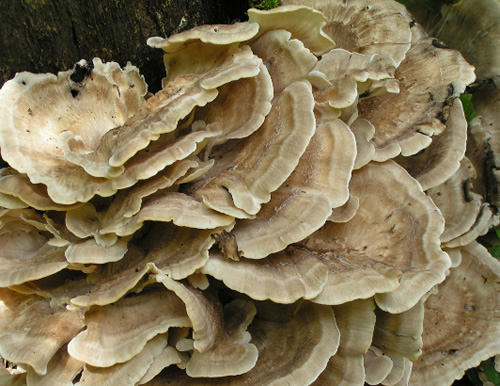
Observer: Paul Lauenstein
Observation Date: 9/7/20
Observation Time: 5:45 p.m.
Observation Location: conservation land near Lakeview & Morse
Common Name: Brittle Gill Mushroom
Scientific Name: Russula pulchra
Comments: Wikipedia lists an enormous number of Russula species, so I am not certain of this identification.
More Information: Mushroom Expert
Observer: Paul Lauenstein
Observation Date: 9/7/20
Observation Time: 5:40 p.m.
Observation Location: conservation land near Lakeview & Morse
Common Name: Chicken of the Woods
Scientific Name: Laetiporus sulphureus
Comments: These relatively small specimens were growing on a dead oak tree. Chicken of the Woods can grow to very large size. They are edible, but it is wise to refrain from eating any wild-harvested food unless you are absolutely sure it is not poisonous. As the saying goes, everything is edible – at least once!
More Information: Wikipedia
Observer: Hana Jenner
Observation Date: 6/9/19
Observation Time: 2:20 p.m.
Observation Location: on a log beside a trail near Brook Road
Common Name: Crown-tipped Coral Fungus
Scientific Name: Artomyces pyxidatus
Comments: This is one of the few coral fungi found on decaying wood. The crown-like tips of the branches are unlike those of any of the other coral fungi, thus making this species relatively easy to identify.
More Information: University of Arkansas mushroom species list
Observer: Gaurav Shah
Observation Date: 7/1/23
Observation Time: 4:00 p.m.
Observation Location: trail off Billings St.
Common Name: Crown-tipped Coral Fungus
Scientific Name: Artomyces pyxidatus
Comments: This is one of the few coral fungi found on decaying wood. The crown-like tips of the branches are unlike those of any of the other coral fungi. Seek (the free cell phone app) readily identified it.
More Information: University of Arkansas mushroom species list
Observer: Paul Lauenstein
Observation Date: 9/30/10
Observation Time: 6:10 p.m.
Observation Location: Gavins Pond Road
Common Name: Fly Agaric mushroom
Scientific Name: Amanita muscaria
Comments: Mushrooms of the genus Amanita account for most mushroom-related deaths. See: http://www.a1b2c3.com/drugs/var012.htm
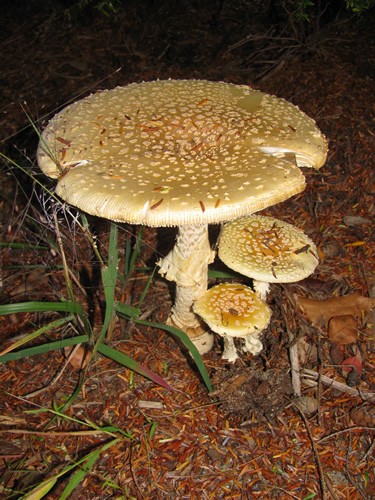
Observer: Paul Lauenstein
Observation Date: 9/26/12
Observation Time: 2:05 p.m.
Observation Location: Near the train station tennis courts by Beaver Brook
Common Name: Honey Mushroom
Scientific Name: Armillaria mellea
Comments: Honey mushrooms are a plant pathogen and cause Armillaria root rot in many plant species. They appear around the base of trees they have infected. The symptoms of infection appear in the crowns of infected trees as discolored foliage, reduced growth, dieback of the branches and death. The mushrooms are edible but some people may be intolerant to them. This species is capable of producing light via bioluminescence in its mycelium.
Armillaria mellea is widely distributed in temperate regions of the Northern Hemisphere. The fruit body or mushroom, commonly known as stump mushroom, stumpie, honey mushroom, pipinky or pinky, grows typically on hardwoods but may be found around and on other living and dead wood or in open areas.
More Information: Wikipedia
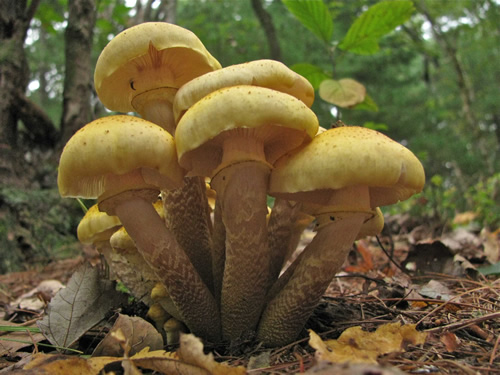
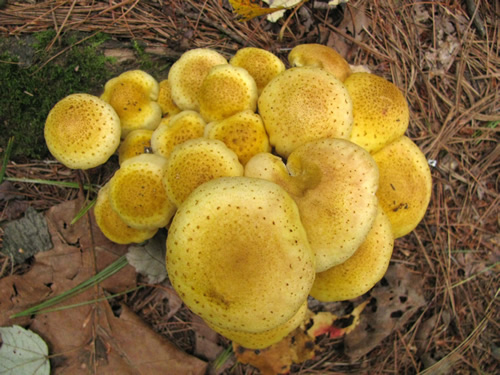
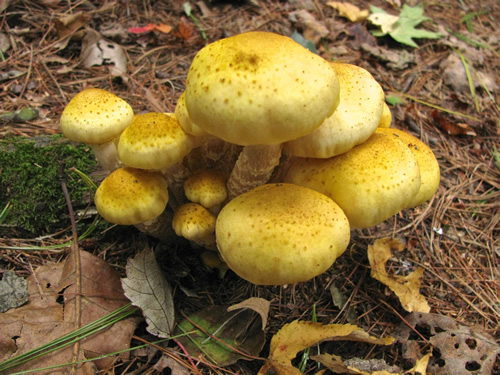
Observer: Paul Lauenstein
Observation Date: 10/17/10
Observation Time: 10:00 a.m.
Observation Location: 4 Gavins Pond Road
Common Name: Lingzhi mushroom
Scientific Name: Ganoderma tsugae
Comments: This mushroom specimen was growing in the tamarack (larch) grove in my back yard. It is probably growing on a root, as it was growing on the ground right next to a big tamarack tree. Since tamaracks are coniferous, this specimen is presumably Ganoderma tsugae, rather than Ganoderma lucidum, which grows on deciduous trees.
Apparently, these mushrooms are valued for their medicinal properties.
More Information: Cornell Mushroom Blog
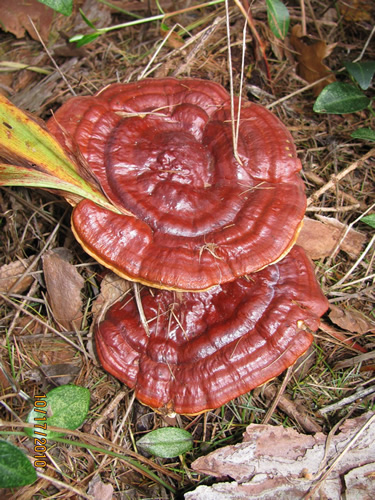
Observer: Constance Keegan
Observation Date: 10/1/10
Observation Time: Daytime
Observation Location: By a large oak tree in my yard on Moosehill Pkwy
Common Name: Maitake mushroom
Scientific Name: Grifola frondosa
Comments: Also called “hen of the woods,” G. frondosa should not be confused with Laetiporus sulphureus, another edible bracket fungus that is commonly called “chicken of the woods.” Like all polypores, the fungus becomes inedible when older, because it is then too tough to eat.
More Information: Wikipedia
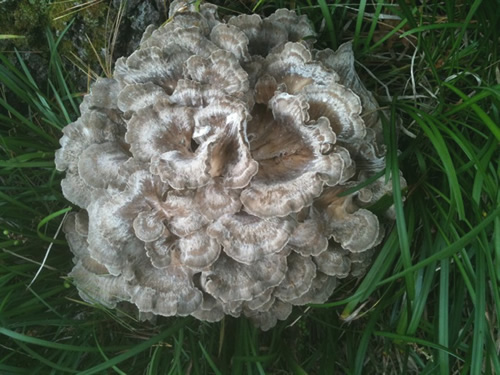
Observer: Lonnie Friedman
Observation Date: 5/30/20
Observation Time: 5:00 pm
Observation Location: near Gavins Pond
Common Name: Oyster Mushroom
Scientific Name: Pleurotus ostreatus
Comments: This oyster mushroom was growing on a log. I believe it to be edible, but I did not dare test that hypothesis!
More Information: Wikipedia
Here’s the first photo taken 5/30/20:
To confirm the identification, I returned the following afternoon and took these photos to show the “gills” on the underside of the mushrooms:
Top view, photographed on 5/31/20 at around 1:15 pm:
Observer: Josh Simons
Observation Date: 9/9/20
Observation Time: 11:00 a.m.
Observation Location: Moose Hill area
Common Name: Parasol mushroom
Scientific Name: Macrolepiota procera
Comments: iNaturalist says this is a parasol mushroom. I thought they had rounded caps, but I do see some flat tops when googling. This was large – maybe 5″ to 6″ in diameter. Very pretty.
More Information: Mushroom-Collecting.com
Observer: Paul Lauenstein
Observation Date: 9/9/12
Observation Time: 2:50 p.m.
Observation Location: Sandy Ridge Circle
Common Name: Pigskin Poison Puffball
Scientific Name: Scleroderma citrinum
Comments: Also known as “common earthball,” this yellow-white spherical fungus has no stem. It eventually bursts open to release spores.
More Information: Common Earthball
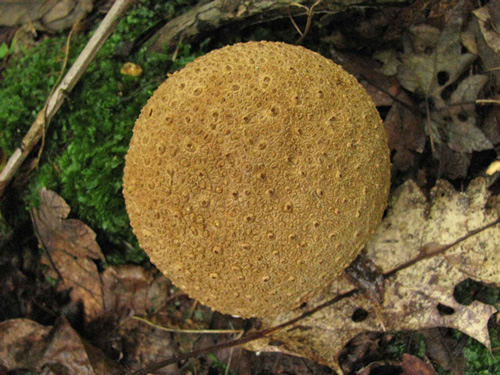
Observer: Paul Lauenstein
Observation Date: 6/13/20
Observation Time: 5:55 p.m.
Observation Location: Moose Hill Wildlife Sanctuary
Common Name: Platterful Mushroom
Scientific Name: Megacollybia rodmani
Comments: Platterful mushrooms appear after May and June rains. It had rained heavily two days earlier. This one was growing on a rotting log beside the trail.
More Information: Mushroomexpert.com
Top view:
Observer: Paul Lauenstein
Observation Date: 9/20/15
Observation Time: 4:20 p.m.
Observation Location: Lake Massapoag (near boat ramp)
Common Name: Puffball mushroom
Scientific Name: Genus: Calvatia, Bovista and others
Comments: There are many kinds of puffballs. Some are edible and some are poisonous.
More Information: eattheplanet.org
Observer: Lonnie Friedman
Observation Date: 7/11/20
Observation Time: 3:20 p.m.
Observation Location: Moose Hill Audubon Wildlife Sanctuary
Common Name: Red Chanterelle Mushroom
Scientific Name: Cantharellus cinnabarinus
Comments: Red chanterelles are fungi native to eastern North America. They are members of the genus Cantharellus along with other chanterelles. They are named after their red color, which is imparted by the carotenoid canthaxanthin. They are edible, fruiting in association with hardwood trees in the summer and fall.
It looks like something was chewing on the red chanterelles in these photos. It is a bad idea to ingest wild mushrooms unless you are absolutely certain you know what your are eating, because many mushrooms are poisonous.
More Information: iNaturalist
Observer: Kurt Buermann
Observation Date: 7/30/2017
Observation Time: N/A
Observation Location: Rattlesnake Hill, Sharon
Common Name: Red Chanterelle mushroom (a.k.a. Cinnabar Chanterelle mushroom)
Scientific Name: Cantharellus cinnabarinus
Comments: Sought after edible mushroom with slight peppery taste and slight apricot aroma.
DON’T EAT WILD MUSHROOMS UNLESS YOU ARE ABSOLUTELY SURE THEY ARE NOT POISONOUS!
More Information: The Mushroom Forager
Observer: Josh Simons
Observation Date: 9/17/20
Observation Time: 3:00 p.m.
Observation Location: Moose Hill area
Common Name: Ringless Honey Mushroom
Scientific Name: Armillaria tabescens
Comments: These ringless mushrooms extended almost all the way around the tree.
WARNING: This is NOT a beginner’s mushroom. Never eat any wild plant unless you are 100% sure that you have identified an edible species.
More Information: The Foraged Foodie
Observer: Paul Lauenstein
Observation Date: 9/9/12
Observation Time: 3:10 p.m.
Observation Location: Sandy Ridge Circle
Common Name: Russula mushroom
Scientific Name: Russula spp.
Comments: I don’t know which species of Russula this specimen happens to be.
More Information: Wikipedia
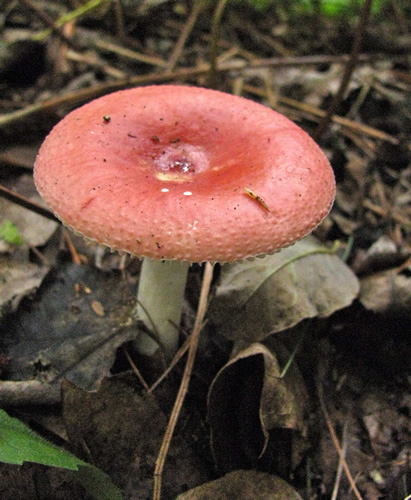
Observer: Paul Lauenstein
Observation Date: 5/28/23
Observation Time: 9:10 a.m.
Observation Location: Moose Hill Farm (TTOR)
Common Name: Rust Fungus
Scientific Name: genus Pucciniaceae
Comments: Rust fungus is a plant disease. This rust fungus was growing on buckthorn leaves.
More Information: Wikipedia
Observer: Paul Lauenstein
Observation Date: 9/22/13
Observation Time: 2:20 p.m.
Observation Location: King Phillip’s Rock area
Common Name: Sulphur Shelf Mushroom
Scientific Name: Laetiporus sulphureus
Comments: Sulphur shelf mushrooms are reportedly edible, but never eat a mushroom you find in the woods unless you are absolutely sure it is not poisonous. More pictures of sulphur shelf mushrooms can be seen at: http://hicksroad.com/html/stumpfun.htm.
More Information: Wikipedia
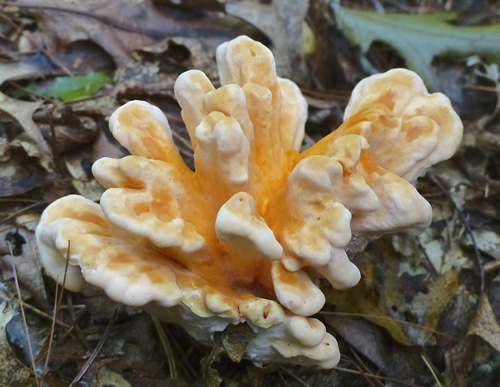
Observer: Paul Lauenstein
Observation Date: 5/13/19
Observation Time: 11:10 a.m.
Observation Location: Moose Hill Audubon Wildlife Sanctuary
Common Name: Turkey-tail Fungus
Scientific Name: Trametes versicolor
Comments: This could also be false turkey-tail lichen. I neglected to inspect the underside to see if it had pores.
More Information: Edible Wild Food
Observer: Paul Lauenstein
Observation Date: 5/30/10
Observation Time: 4:00 p.m.
Observation Location: Moose Hill Audubon Wildlife Sanctuary
Common Name: Violet toothed polypore
Scientific Name: Trichaptum biforme
Comments: Tree fungus growing on a dead tree. The specimens in this photo are past their prime. Younger specimens exhibit a violet fringe that gives this fungus its name. See http://www.flickr.com/photos/ophis/3067412819/
More Information: InsectImages
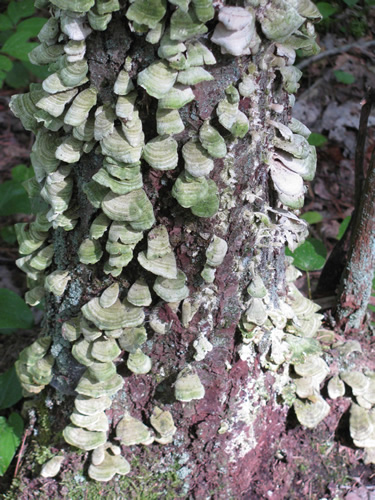
Observer: Paul Lauenstein
Observation Date: 9/9/12
Observation Time: 3:00 p.m.
Observation Location: Sandy Ridge Circle
Common Name: Viscid Violet Cort mushroom
Scientific Name: Cortinarius iodes
Comments: This striking violet mushroom has a watery sheen.
More Information: American Mushrooms
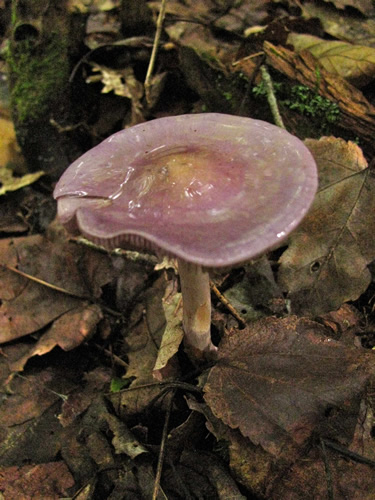
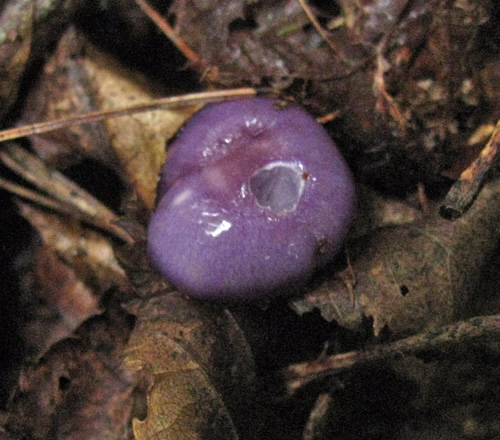
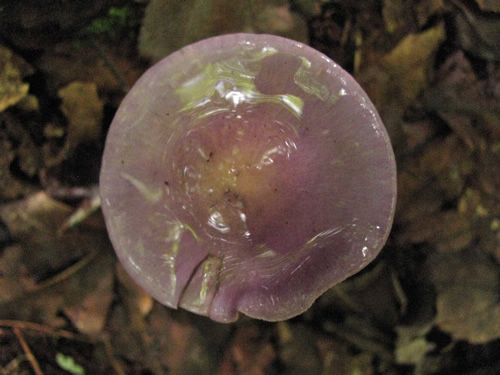
Observer: Paul Lauenstein
Observation Date: 6/23/19
Observation Time: 11:30 a.m.
Observation Location: Botanical Trail
Common Name: Witch’s Butter Fungus
Scientific Name: Tremella mesenterica
Comments: Although the species appears to be growing on wood, it is actually a parasite on the (usually hidden) mycelium of a crust fungus.
More Information: MushoomExpert.com
Observer: Paul Lauenstein
Observation Date: 7/13/19
Observation Time: 11:30 a.m.
Observation Location: near footbridge over Beaver Brook
Common Name: Yellow Patches Mushroom
Scientific Name: Amanita flavoconia
Comments: Amanita flavoconia, commonly known as yellow patches, yellow wart, orange Amanita, or yellow-dust Amanita, is a species of mushroom in the family Amanitaceae. It has an orangish-yellow cap with yellowish-orange patches or warts, a yellowish-orange annulus, and a white to orange stem. Common and widespread throughout eastern North America, Amanita flavoconia grows on the ground in broad-leaved and mixed forests, especially in mycorrhizal association with hemlock.
Mushrooms of the genus Amanita account for most mushroom-related deaths.
More information: iNaturalist

